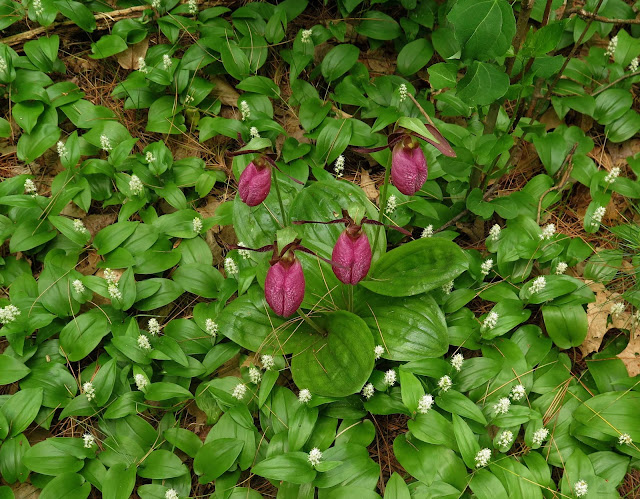At a casual glance, this sandy-soiled powerline clearcut just north of Mud Pond at Moreau Lake State Park doesn't exactly look like a hotbed of rare plants. But it is. And thanks to efforts by Casey Holzworth, Natural Resource Steward for our region's state parks, those plants will no longer have to endure periodic herbicide applications by the power company, intended to keep trees from interfering with the lines. After a number of state-protected plants were reported from this site, Casey met with a National Grid supervising forester, who consented to allow the park to assume vegetation management for the stretch of trail visible in this photo, which is where most of the plants requiring protection are known to grow. I visited this stretch today, curious to see how our rare and otherwise protected plants were doing.
I didn't have to search very long to find the first Rare plant, our native American Bittersweet (Celastrus scandens) with its flowers now in bud. An abundant patch lies close to the trail, easily accessed from a nearby parking area.
As I descended the sandy path toward the pond, I began to find the first of dozens of plants of Green Rock Cress (Borodinia missouriensis), rated as a Threatened species in New York. Although its small white four-petaled flowers look very much like those of other Mustard Family plants, its slender, arching seed pods are its most distinctive field mark. As this photo reveals, those arching seed pods (called "siliques") have already begun to form and acquire their distinctive profile.
As it happened today, a similar Mustard Family plant called Tower Mustard (Turritis glabra) was also blooming nearby. Tower Mustard is a quite common native species, and I placed a stalk of it next to a plant of Green Rock Cress to display how these two tall slender plants with very similar small white flowers actually differ substantially.
Even at a glance, it is obvious how the siliques appear vastly different, even though both are long and slender. Those of the Green Rock Cress are flexible and arch away from the stem in graceful curves, while those of the Tower Mustard are stiff, and they cling closely to the plant's stem as they point directly upward. And while both species bear terminal clusters of small white flowers, only the Tower Mustard will bear more flowers from the leaf axils along the stem.
Here is one more plant under these powerlines that is classified by New York State as "Rare", our native Wild Lupine (Lupinus perennis). I do see this plant in many other places around Saratoga County besides this, so I had no idea it was considered a rare plant until I checked the New York Flora Association Plant Atlas. We do have very sandy soil in this county, which is exactly the kind of low-nutrient habitat that this species prefers, so that might account for its abundance locally. It also prefers burned-over sites, and the Plant Atlas suggests that it may be decreasing in abundance as fires are prevented. I have often thought that the clear-cut areas under powerlines do resemble the clearings caused by forest fire, so it should not be surprising that Wild Lupine likes it here. That's one more reason to rejoice that herbicides will no longer poison the wildflowers under these powerlines!
If I want to find this next wildflower, the Pink Lady's Slipper (Cypripedium acaule), I often visit this powerline near Mud Pond, where this beautiful native orchid grows in abundance. But I find it not out under the power lines, but rather back toward the edge of the pine woods that lines the trail here. Although this plant is not state-listed as "Rare," it is, as are all our native orchids, a protected species in New York, classified as "Exploitably Vulnerable".
The same would be true for a second milkweed that could thrive here more abundantly than it does now, the brilliant-orange, aptly named Butterfly Weed (Asclepias tuberosa), seen here sharing its space with another plant much desired by native pollinators, the white-flowered shrub called New Jersey Tea (Ceanothus americanus).
Did I mention that Butterfly Weed was aptly named? This lovely little American Copper Butterfly attests to that!






















































